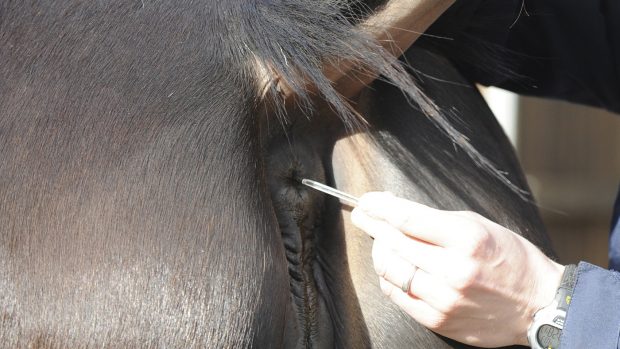Although saddle rash is easily confused with rain scald, the two skin complaints are poles apart.
The horse’s back receives pressure from rider, saddle and tack which causes sweating, particularly under the pressure points. The skin on the back is also subject to some important and problematic diseases – and any pain or discomfort in that area may make the horse unrideable.
Saddle rash
Saddle rash is caused by a staphylococcal bacterial infection of the hair follicles (staphylococcal folliculitis). The inflammation of the hair follicles results in a painful, moist “eczematous” reaction. The name eczema should not be used, as it simply means a skin inflammation.
Pain and skin moistening over the saddle area is the major sign of this condition, but a similar dermatitis can develop on other parts of the horse’s body from the same infection, particularly on white skinned pasterns and cannons. The vet confirms the diagnosis by taking swabs from the deeper areas of the skin – but even taking a swab from the skin is painful for the horse.
Causes
Saddle rash is more common in the late winter or early spring when the summer coat begins to develop. Around this time, horses tend to be rugged up heavily and theweather starts to warm up. A dirty rug and poor grooming, either by being overzealous and grooming too hard with a sharp brush or through under-grooming – leaving dirt and sweaty hair on the skin surface can also be a factor.
The cause is a combination of a long, dense coat with sweating, poor grooming and dirty rugs. As the levels of infection on the skin increase over the winter months, the disease is more likely to develop at this time. Failure to recognise and resolve the problem quickly can lead to a permanently “cold-backed” horse, although the disease may have been treated successfully.
Mistaken identity
The location of the skin damage means it can easily be mistaken for “rain scald” but, although the latter is uncomfortable, it is almost never painful. It is fairly easy to distinguish the two diseases, both on appearance and in the laboratory, and it is crucial this is done to ensure that the horse receives the correct treatment.
Some cases of dermatitis on the back/saddle areas are unfortunately due to chemical burns – this is relatively common when strong/undiluted antiseptics, shampoos – or even hot water – are applied. Always read the instructions carefully and tell your vet what you are using, saying how you used it. This helps the vet make the correct diagnosis and prescribe the right treatment.
Difficult disease
It is not easy to treat saddle rash because the infection becomes harboured deep in the skin. So it is difficult for any topical antiseptic shampoo to get to the bacteria and, because the infection lies within the skin, antibiotics given by mouth or injection also cannot reach the skin in concentrations suitable to kill the infection. As many of the strains of bacteria are resistant, or partially resistant, to many antibiotics, their value is debatable.
The earliest signs of pain and moistness over the back should be identified and action taken immediately. The vet often needs to sedate the horse heavily and give him painkillers to allow the condition to be treated. Close clipping of the whole affected area is essential – this area is often much bigger than it looks at first.
One of the biggest mistakes is to use strong disinfectants on the skin as the skin is already extremely inflamed and sore. Suitable washes are available, but you must follow the vet’s instructions before using them. Under no circumstances should human shampoos and skin washes be used. Repeated washes are usually needed, but a few cases resolve quickly without any complications.
Complications
Long-term back reaction to pressure is the most likely significant effect, which can last for the lifetime of the horse, although there are other causes of a “cold-back”.
Preventative methods
The best way to prevent skin rash is to ensure that your horse has a healthy and clean skin. It is worth using a medicated horse shampoo from time to time over the winter, following the manufacturer’s instructions closely.Rugs and blankets should be washed regularly and should never be shared with other horses. A clean cotton undersheet or sweat rug, used under blankets or waterproof rugs, can be washed easily every few days.
Saddle sores/marks
Saddle sores are usually caused by a poor-fitting saddle or inappropriate tack. These are normally found around the withers, where the skin is thin and there is no cushioning muscle or fat. Saddle marks are groups of white hairs and hairless areas where the saddle or tack makes contact with the horse. They occur because the cells that produce the normal colour of the hair have been damaged. When the damage is severe, there may be scarring or the hair-producing cells become destroyed completely, which produces a hairless area.
Saddle fitting is a science and qualified fitters and saddlers should always be used to obtain the best fit for your horse. It may need to be adjusted in several areas to give a comfortable and safe “fit”. There is a tendency, however, to “pad-up” inadequate fitting saddles with numnahs, but this only makes matters worse as they tend to ruche and fold, or pull downwards, creating a tight band across the withers. Most saddle sores are not obvious -sometimes white hair (saddle marks) are all that you can see.
Collagen granulomas
The most common skin nodules on the horse’s back are collagen granulomas, which are small, hard nodules where pressure has been applied, such as the saddle area. The nodules are not usually painful, although if many develop at once they may cause the horse discomfort.
There is some debate over whether they are caused by insect bites or pressure, or both. As the nodules age, they can become calcified and remain in the skin as small, painless, hard lumps. Troublesome nodules can be removed surgically fairly easily, but it is usually best to leave them alone.
Warbles
As warble flies are becoming rarer, fewer horses are affected these days. The fly normally lays its eggs on cattle, buta few develop in horses. The usual sign of infection is a single or a few lumps in the back region, which develop in the winter and early spring. The larva burrows its way from the horse’s intestine to the skin of the back over winter and produces a lump in the skin which is warm, swollen and painful to the touch.
Careful clipping will often reveal a small breathing pore in the centre of the lump and eventually a maggot will emerge from it. Thereafter, the whole area will calm down, leaving littletrace of a problem. However, it can take several weeks to resolve, during which the horse cannot be worked easily. Using a numnah with a hole cut into it may help.Horses which are adequately wormed with an ivermectin-based wormer during the winter will seldom, if ever, develop skin lumps from this parasite.


